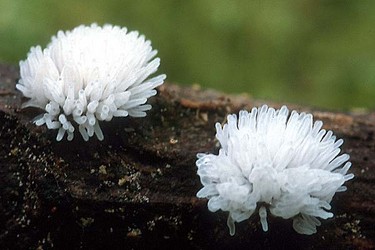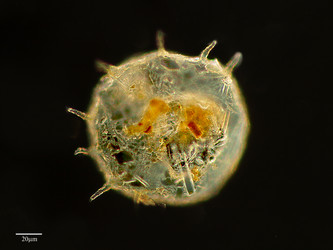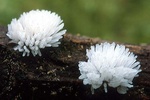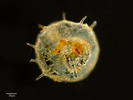Amoebozoa



This tree diagram shows the relationships between several groups of organisms.
The root of the current tree connects the organisms featured in this tree to their containing group and the rest of the Tree of Life. The basal branching point in the tree represents the ancestor of the other groups in the tree. This ancestor diversified over time into several descendent subgroups, which are represented as internal nodes and terminal taxa to the right.

You can click on the root to travel down the Tree of Life all the way to the root of all Life, and you can click on the names of descendent subgroups to travel up the Tree of Life all the way to individual species.
For more information on ToL tree formatting, please see Interpreting the Tree or Classification. To learn more about phylogenetic trees, please visit our Phylogenetic Biology pages.
close boxTitle Illustrations

| Scientific Name | Ceratiomyxa fruticulosa |
|---|---|
| Specimen Condition | Live Specimen |
| Source | ceratiomyxa fruticulosa |
| Source Collection | Flickr |
| Image Use |
 This media file is licensed under the Creative Commons Attribution-NonCommercial-ShareAlike License - Version 2.0. This media file is licensed under the Creative Commons Attribution-NonCommercial-ShareAlike License - Version 2.0.
|
| Copyright | © 2008 MAVI RODRIGUEZ GARCIA |
| Scientific Name | Centropyxis discoides |
|---|---|
| Location | Zamora, Castilla y León, Spain |
| Comments | La ameba que mostrábamos ayer soporta las aguas heladas de las lagunas de montaña sin ningún tipo de abrigo. La de hoy, algo más delicada, tiene que buscar refugio y lo hace en una casa de cristal que ella misma ha fabricado empleando, sobre todo, restos de los caparazones de cristal de gran cantidad de diatomeas. Ha podido construir así una casa casi transparente y muy resistente - confeccionada además como si se tratase de una obra de arte- en este caso una vidriera abstracta. Centropyxis discoides es nuestra ameba de hoy, bien distinta a la Trichamoeba de ayer. Se caracteriza porque la abertura del caparazón se sitúa casi en posición central y por poseer, generalmente, más espinas que la otra especie hermana de la que ya hemos hablado en nuestra galería: Centropyxis aculeata. Nuestra ameba vive en aguas estancadas y sobre los esfagnos de las turberas, se alimenta de restos vegetales y de diatomeas y procede de las muestras recolectadas hace unos días en las inmediaciones de la Laguna de Peces en la Alta Sanabria de Zamora, en un marco incomparable por su belleza. La fotografía se ha tomado con 400 aumentos empleando la técnica de ampo oscuro. También en www.iesbatalladeclavijo.com/tablon/webvidaoculta/index.html y en www.fotolog.com/proyectoagua. Y por la paz en http://www.fund-culturadepaz.org/spa/03/cent03Articulos%202003/En_pie_de_paz.pdf |
| Source | LA CASA DE CRISTAL DE CENTROPYXIS DISCOIDES |
| Source Collection | Flickr |
| Image Use |
 This media file is licensed under the Creative Commons Attribution-NonCommercial-NoDerivs License - Version 2.0. This media file is licensed under the Creative Commons Attribution-NonCommercial-NoDerivs License - Version 2.0.
|
| Copyright | © 2009 ANTONIO GUILLÉN |
About This Page
Page copyright © 2009
 Page: Tree of Life
Amoebozoa.
The TEXT of this page is licensed under the
Creative Commons Attribution-NonCommercial License - Version 3.0. Note that images and other media
featured on this page are each governed by their own license, and they may or may not be available
for reuse. Click on an image or a media link to access the media data window, which provides the
relevant licensing information. For the general terms and conditions of ToL material reuse and
redistribution, please see the Tree of Life Copyright
Policies.
Page: Tree of Life
Amoebozoa.
The TEXT of this page is licensed under the
Creative Commons Attribution-NonCommercial License - Version 3.0. Note that images and other media
featured on this page are each governed by their own license, and they may or may not be available
for reuse. Click on an image or a media link to access the media data window, which provides the
relevant licensing information. For the general terms and conditions of ToL material reuse and
redistribution, please see the Tree of Life Copyright
Policies.
- First online 28 October 2009
- Content changed 28 October 2009
Citing this page:
Tree of Life Web Project. 2009. Amoebozoa. Version 28 October 2009 (temporary). http://tolweb.org/Amoebozoa/121165/2009.10.28 in The Tree of Life Web Project, http://tolweb.org/









 Go to quick links
Go to quick search
Go to navigation for this section of the ToL site
Go to detailed links for the ToL site
Go to quick links
Go to quick search
Go to navigation for this section of the ToL site
Go to detailed links for the ToL site